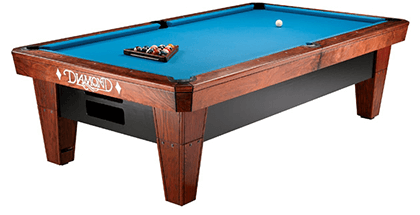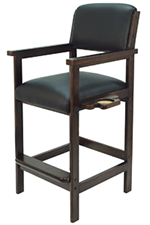The Rules of Play From World Pool-Billiard Association (Effective 1/1/08)
The following definitions apply throughout these rules.
8.1 Parts of the Table
The following definitions of parts of the table refer to the accompanying diagram.

The table is comprised of rails, cushions, a playing surface and pockets. The foot end of the table is where the object balls usually begin, while the head end is where the cue ball usually begins. Behind the head string is the area between the head rail and the head string, not including the head tring. The cushions, tops of the rails, pockets and pocket liners are parts of the rails.
There are four “strings” on the playing surface as shown in the diagram:
- the long string down the center of the table;
- the head string bounding the quarter of the table closest to the head rail;
- the foot string bounding the quarter of the table closest to the foot rail; and
- the center string between the two side pockets.
These lines are only marked as mentioned below.
The rails may have inlays referred to as diamonds or sights which mark 1/4th of the width and 1/8th of the length of the table measured from nose to nose on the cushions. On the playing surface, which is the flat, cloth-covered part of the table, the following will be marked if they are used in the game being played:
- the foot spot, where the foot string and the long string meet;
- the head spot, where the head string and the long string meet;
- the center spot, where the center string and the long string meet;
- the head string;
- the long string between the foot spot and the foot rail; and
- the triangle, either in outline or by alignment marks depending on the game.
8.2 Shot
A shot begins when the tip contacts the cue ball due to a forward stroke motion of the cue stick. A shot ends when all balls in play have stopped moving and spinning. A shot is said to be legal if the shooter did not foul during the shot.
8.3 Ball Pocketed
A ball is pocketed if it comes to rest in a pocket below the playing surface or enters the ball return system. A ball near the brink of a pocket partly supported by another ball is considered pocketed if removal of the supporting ball would cause the ball to fall into the pocket.
If a ball stops near the edge of a pocket, and remains apparently motionless for five seconds, it is not considered pocketed if it later falls into the pocket by itself. See 1.7 Balls Settling for other details. During that five second period, the referee should ensure that no other shot is taken. An object ball that rebounds from a pocket back onto the playing surface is not a pocketed ball. If the cue ball contacts an already pocketed ball, the cue ball will be considered pocketed whether it rebounds from the pocket or not. The referee will remove pocketed object balls from full or nearly full pockets, but it is the shooter’s responsibility to see that this duty is performed.
8.4 Driven to a Rail
A ball is said to be driven to a rail if it is not touching that rail and then touches that rail. A ball touching a rail at the start of a shot (said to be “frozen” to the rail) is not considered driven to that rail unless it leaves the rail and returns. A ball that is pocketed or driven off the table is also considered to have been driven to a rail. A ball is assumed not to be frozen to any rail unless it is declared frozen by the referee, the shooter, or the opponent. See also Regulation 26, Calling Frozen Balls.
8.5 Driven off the Table
A ball is considered driven off the table if it comes to rest other than on the playing surface but is not pocketed. A ball is also considered driven off the table if it would have been driven off the table except for striking an object such as a light fixture, piece of chalk or a player which causes it to return to the table.
A ball that contacts the top of the rail is not considered to have been driven off the table if it returns to the playing surface or enters a pocket.
8.6 Scratch
A shot on which the cue ball is pocketed is called a scratch.
8.7 Cue Ball
The cue ball is the ball that is struck by the shooter at the beginning of a shot. It is traditionally white, but may be marked by a logo or spots. In pocket billiard games, a single cue ball is used by both players.
8.8 Object Balls
The object balls are struck by the cue ball with the usual intent of driving them into pockets. They are typically numbered from one to the number of balls used in the game. Colors and markings of the object balls are covered under the WPA Equipment Specifications.
8.9 Set
In some matches, the match is divided into parts called sets, with a certain number of sets won required to win the match. In turn, a certain number of points or racks won is required to win each set.
8.10 Rack
The rack is the framing device, typically triangular, used to arrange the object balls for the break shot at the start of the game. It also refers to the group of balls so arranged. To rack the object balls is to group them with the rack. A rack is also a portion of a match played with a single rack of object balls. Some games, such as nine ball, are scored at one point per rack.
8.11 Break
A break shot is the opening shot of a match or rack, depending on the game. It happens when the object balls have been racked and the cue ball is played from behind the head string usually with the intent of breaking the rack apart.
8.12 Inning
An inning is a player’s turn at the table. It begins when it is legal for him to take a shot, and ends at the end of a shot when it is no longer legal for him to take a shot. In some games a player may choose not to come to the table in certain situations when play would normally pass to him, and then the player remaining at the table continues the inning (e.g. a 2.4 push-out at nine ball). The player whose turn it is to play is called the “shooter.”
8.13 Position of Balls
The position of a ball is determined by the projection of its center vertically downward onto the playing surface. A ball is said to be placed on a line or spot when its center is placed directly over that line or spot.
8.14 Re-spotting Balls
In some games, object balls are required to be placed on the playing surface other than when forming a new rack. They are said to be re-spotted when they are so placed. See 1.4 Spotting Balls.
8.15 Restoring a Position
If the balls are disturbed, the rules of the game may require them to be replaced where they were. The referee will replace the balls to their original position as accurately as possible.
8.16 Jump Shot
A jump shot is one in which the cue ball is made to go over an intervening obstacle such as an object ball or part of the cushion. Whether such a shot is legal depends on how it is accomplished and the intention of the shooter. Usually a legal jump shot is played by elevating the cue stick and driving the cue ball down into the playing surface from which it rebounds.
8.17 Safety Shot
A shot is said to be a safety shot if the game in play is a call shot game and the shooter declared the shot to the referee or his opponent to be a “safety” before the shot. Play passes to the other player at the end of a safety shot.
8.18 Miscue
A miscue occurs when the cue tip slides off the cue ball possibly due to a contact that is too eccentric or to insufficient chalk on the tip. It is usually accompanied by a sharp sound and evidenced by a discoloration of the tip. Although some miscues involve contact of the side of the cue stick with the cue ball, unless such contact is clearly visible, it is assumed not to have occurred. A scoop shot, in which the cue tip contacts the playing surface and the cue ball at the same time and this causes the cue ball to rise off the cloth, is treated like a miscue. Note that intentional miscues are covered by 6.16 Unsportsmanlike Conduct (c).


 Free Shipping with Tracking on orders over $100 within the Continental USA.
Free Shipping with Tracking on orders over $100 within the Continental USA. 




